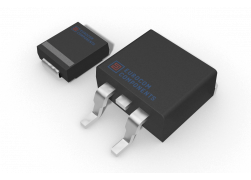Filter
Please note:

Minimum order amount: 500 UAH
Quantity of SMD: multiples 100 pcs
Buy Schottky diodes SMD with delivery across Kiev and Ukraine
General parameters of models and functional differences of Schottky diodes
Schottky diode characteristics.
- The forward voltage drop of a Schottky diode is much lower than that of a fast recovery diode, so its own power consumption is low and its efficiency is high. 2. Since the recovery time of the reverse charge is very short, it is suitable for high frequency operation.
- It can withstand high impulse currents.
- The highest junction temperature of Schottky tubes generally available on the market is 100 ° C, 125 ° C, 150% and 175 ° C (the higher the junction temperature, the better the temperature resistance of the product.Operation below this temperature will not cause invalidation.
- It also has disadvantages: less withstand voltage and slightly more reverse leakage current. The choice must be carefully considered. Schottky diodes are commonly used to rectify the secondary output of power supplies.
- Schottky is a low-power, ultra-fast semiconductor device that is widely used in switching power supplies, inverters, drivers and other circuits for high frequency, low voltage, high current rectifier diodes, freewheel diodes, and protection diodes. Or used as rectifier diodes and diodes for weak signal detectors in circuits such as microwave communication.
- Schottky diode structure.. Schottky diodes are very different from PN junction diodes in terms of structural principles. Their inner part is made of anode metal (a barrier layer of materials such as molybdenum or aluminum), silicon dioxide (SiO2). Electric field. elimination material, N epitaxial layer (arsenic material), N-type silicon substrate, N cathode layer and cathode metal.
A Schottky barrier is formed between the N-type substrate and the anode metal.
When forward bias is applied to both ends of the Schottky barrier (the anode metal is connected to the positive pole of the power supply and the N-type substrate is connected to the negative pole of the power supply), the Schottky barrier layer becomes narrower and its internal resistance becomes lower; conversely, if by applying reverse bias to both ends of the Schottky barrier, the Schottky barrier layer becomes wider and its internal resistance becomes larger.
Schottky diodes are divided into leaded and surface mount packages (IC on a chip).
Lead-cased Schottky diodes are commonly used as high frequency high current rectifier diodes, freewheel diodes or protection diodes. It has two forms of packaging: single tube and twin (double diode).
Schottky also has:
A common cathode (the negative poles of the two tubes are connected), a common anode (the anodes of the two tubes are connected) and
There are three sequential lead-out methods (the anode of one diode is connected to the cathode of another diode).
Schottky diodes that use surface packing are available in one-tube, two-tube, and three-tube types, and there are also A ~ 19 pin pinout methods.
- Using Schottky diodes.
Lead Schottky diodes, 1N5817, 1N5819, MBR1045, MBR20200 and other models are commonly used. Also known as pluggable packaging.
Typically SMD Schottky package diodes are used. Why is the SMD Schottky diode named "SS"?
SCHOTTKY: Take the first letter "S",
SMD: Abbreviation for Surface Mounted Devices, which means Surface Mount Device, the first letter "S" is taken,
The first letter of each of the above two phrases is SS,
Schottky with the lowest current - BAT42 (0.2A); BAT54, BAT54A, BAT54C (0.3A);
Schottky with the highest current - 440 A, for example: 440CMQ030, 444CNQ045; the one that exceeds 440 A must be a module.
The maximum Schottky voltage is 200 V, that is, the Schottky limit voltage is 200 V. The voltage exceeding 200 V must also be a module.
The higher the current, the lower the voltage. These are not the same as SCR components. The current is inversely proportional to the voltage (excluding modules).
Specifications 10A, 20A, 30A can reach 200V. Except for this, there is no 200V voltage specification.
